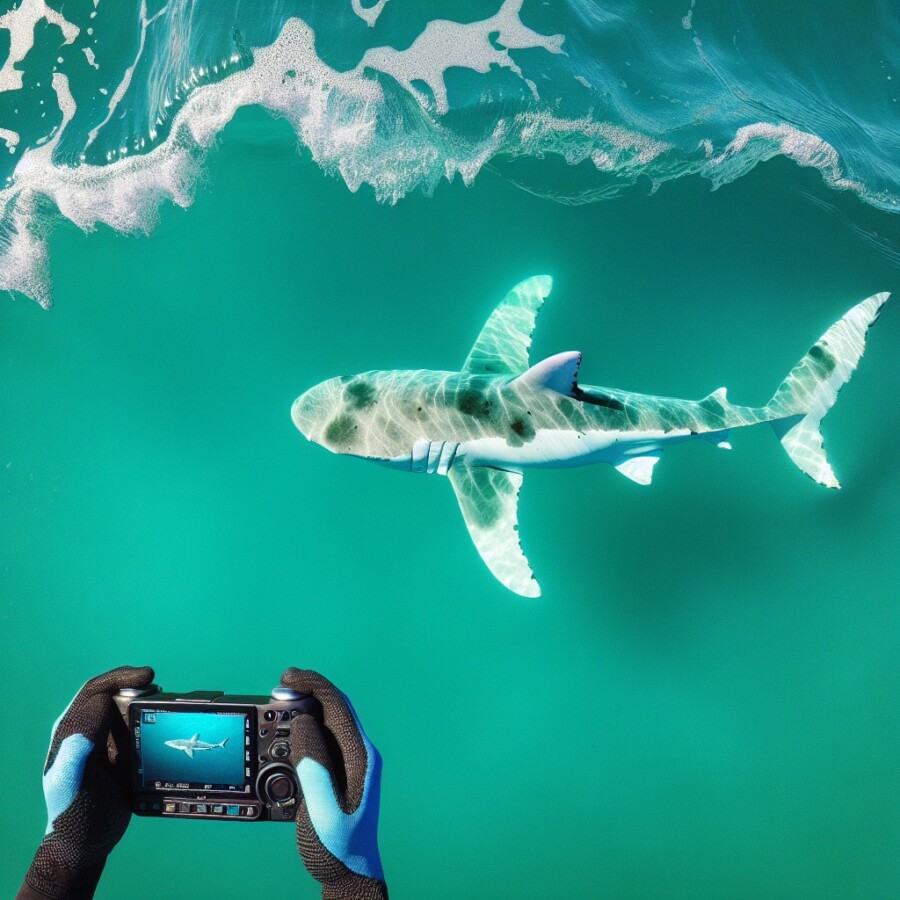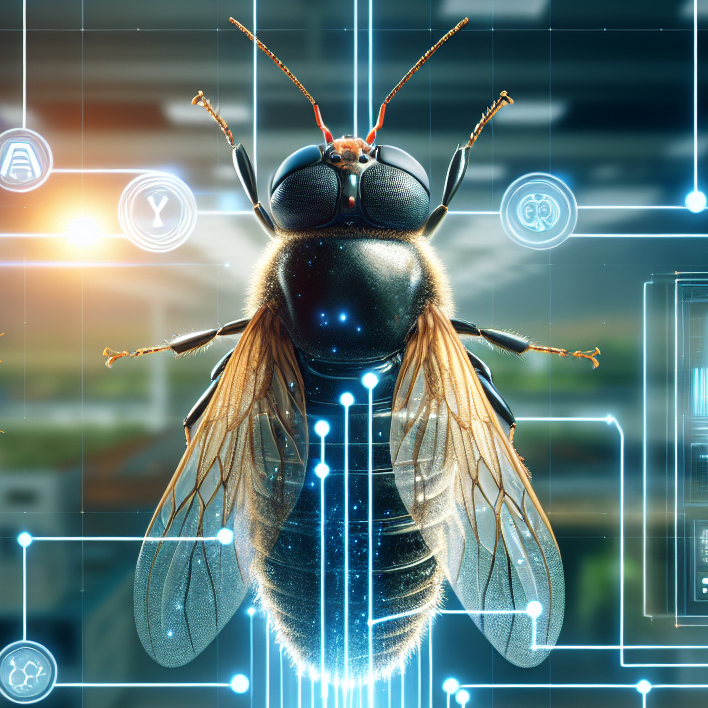A YouTuber named Carlos Gauna, who goes by TheMalibuArtist, might have recorded the first-ever video of a baby great white shark. Carlos is famous for using his drone to film sharks from above, giving us cool and up-close shots of these creatures. His videos often show great whites swimming really close to people, which can be super exciting. Last year, while filming near Santa Barbara, California, Carlos saw a small, white shark that looked like it could be albino. As he got closer with his drone, he noticed that the white layer on the shark seemed to be coming off, which made him think it might be a newborn. Shark researcher Phil Sternes, who was with Carlos at the time, was also really excited about this discovery. The shape of the shark’s fins, which were rounder than usual, suggested that it could be a newborn. James Worthington from the University of San Diego estimated that the shark was about 1.5 meters long, which is normal for a newborn. Their findings were published in the journal Environmental Biology of Fishes. But some marine biologists are saying we should be careful before saying for sure that it’s a baby great white shark. Dr. Chris Lowe from California State University’s shark lab thinks there could be other reasons for the white layer, like a skin disease. He thinks we need more proof before we can say it’s definitely a newborn. Even though some people are skeptical, Carlos and Phil believe that the evidence from the video, like the aggressive flaking, the shape of the fins, and the size of the shark, supports their idea. Drones have changed the way we film sharks, and they’ve given us a lot of cool information about how they behave. Carlos hopes that one day he’ll be able to record the first-ever video of a great white shark being born.
Original news source: Has great white shark newborn been caught on film for the first time? (BBC)
🎧 Listen:
Slow
Normal
Fast
📖 Vocabulary:
| 1 | albino | Having a condition that makes skin, hair, and eyes lack normal color |
| 2 | drone | A flying robot that can take videos or pictures from the sky |
| 3 | skeptical | Doubting or not easily convinced |
| 4 | newborn | Very recently born |
| 5 | aggressive | Acting in a forceful or hostile way |
| 6 | flaking | Peeling off in small pieces |
| 7 | marine | Related to the ocean and its life |
| 8 | biologist | A scientist who studies living organisms and their relationship to their environment |
| 9 | evidence | Information that proves something is true |
| 10 | behavior | The way a living thing acts or conducts itself |
| 11 | estimated | Guessed the size or value of something |
| 12 | discovery | Finding something that was not known before |
| 13 | skeptical | Already used; choose another word |
| 14 | published | Made available to the public in a journal or book |
| 15 | disease | An illness that affects a body part or the whole body |
Group or Classroom Activities
Warm-up Activities:
– News Summary
Instructions: Divide the class into pairs or small groups. Give each group a few minutes to read the article silently. Then, have them work together to create a summary of the article, including the main points and key details. Afterward, have each group share their summary with the class.
– Opinion Poll
Instructions: Write the following statement on the board: “Do you believe the video shows a baby great white shark?” Have the students stand up and move to one side of the room if they agree with the statement, and to the other side if they disagree. Once they have chosen their side, give them a few minutes to discuss their opinions in small groups, and then have a class discussion, allowing students to share their reasons for their opinions.
– Vocabulary Pictionary
Instructions: Prepare a list of vocabulary words from the article (e.g., albino, aggressive, flaking). Divide the class into small groups and give each group a set of vocabulary words. One student from each group will choose a word and draw a picture representing that word, while their group members try to guess the word. Encourage students to use English to describe the word or ask questions if they are unsure.
– Pros and Cons
Instructions: Divide the class into small groups. Assign half of the groups to list the pros (positive aspects) of using drones to film sharks, and the other half to list the cons (negative aspects). Give the groups a few minutes to brainstorm and write down their ideas. Then, have each group share their list with the class and facilitate a discussion about the different perspectives.
– Future Predictions
Instructions: Have the students work individually or in pairs to write a short paragraph predicting what might happen if Carlos is able to record the first-ever video of a great white shark being born. Encourage them to use speculative language (e.g., “If Carlos records the video, it could lead to…”). Afterward, have students share their predictions with the class and discuss their ideas.
🤔 Comprehension Questions:
1. Who is Carlos Gauna and what is he famous for?
2. What did Carlos notice about the small, white shark he saw last year?
3. Why did Carlos and Phil think the shark might be a newborn?
4. What did James Worthington estimate about the length of the shark?
5. What did some marine biologists think about the evidence that Carlos and Phil found?
6. How have drones changed the way we film sharks?
7. What does Carlos hope to do one day with his drone?
8. What is the title of the journal where Carlos and Phil’s findings were published?
Go to answers ⇩
🎧✍️ Listen and Fill in the Gaps:
A YouTuber named (1)______ Gauna, who goes by TheMalibuArtist, might have recorded the first-ever video of a baby (2)______ white (3)______. Carlos is famous for using his drone to film sharks from above, giving us cool and up-close shots of these creatures. His videos often show great whites swimming really close to people, which can be super exciting. Last year, while filming near Santa Barbara, (4)______, Carlos saw a small, white shark that looked like it could be (5)______. As he got closer with his drone, he noticed that the white layer on the shark seemed to be coming off, which made him think it might be a newborn. Shark researcher Phil Sternes, who was with Carlos at the time, was also really excited about this discovery. The shape of the shark’s fins, which were rounder than (6)______, suggested that it could be a newborn. James Worthington from the (7)______ of San Diego (8)______ that the shark was about 1.5 meters long, which is normal for a newborn. Their findings were published in the (9)______ Environmental (10)______ of Fishes. But some (11)______ biologists are saying we should be careful before saying for sure that it’s a baby great white shark. Dr. Chris Lowe from California State University’s shark lab thinks there could be other reasons for the white (12)______, like a skin disease. He thinks we need more proof before we can say it’s definitely a newborn. Even though some people are skeptical, Carlos and Phil (13)______ that the evidence from the (14)______, like the aggressive flaking, the shape of the fins, and the size of the shark, supports their idea. (15)______ have changed the way we film sharks, and they’ve (16)______ us a lot of cool information about how they behave. Carlos hopes that one day he’ll be able to record the first-ever video of a great white shark being born.
Go to answers ⇩
💬 Discussion Questions:
Students can ask a partner these questions, or discuss them as a group.
1. What do you think about the idea of using drones to film sharks?
2. How would you feel if you saw a great white shark swimming really close to you?
3. Do you think it’s possible for a shark to be albino? Why or why not?
4. What other reasons do you think there could be for the white layer on the shark?
5. How do you think drones have changed the way we study and learn about sharks?
6. Do you think it’s important to have more proof before saying for sure that it’s a baby great white shark? Why or why not?
7. Have you ever seen a shark in person? If so, how did it make you feel?
8. Do you think it’s possible to record the first-ever video of a great white shark being born? Why or why not?
9. What other animals do you think would be interesting to film with a drone? Why?
10. How do you think the discovery of a baby great white shark could help us learn more about these creatures?
11. Do you think it’s important to study and protect sharks? Why or why not?
12. Have you ever seen a video or documentary about sharks? If so, what did you learn?
13. How do you think the shape of the shark’s fins can help determine if it’s a newborn or not?
14. Do you like watching videos or documentaries about animals? Why or why not?
15. What other animals do you think would be interesting to film from above with a drone? Why?
Individual Activities
📖💭 Vocabulary Meanings:
Match each word to its meaning.
Words:
1. albino
2. drone
3. skeptical
4. newborn
5. aggressive
6. flaking
7. marine
8. biologist
9. evidence
10. behavior
11. estimated
12. discovery
13. skeptical
14. published
15. disease
Meanings:
(A) Having a condition that makes skin, hair, and eyes lack normal color
(B) Very recently born
(C) A scientist who studies living organisms and their relationship to their environment
(D) An illness that affects a body part or the whole body
(E) The way a living thing acts or conducts itself
(F) Finding something that was not known before
(G) Peeling off in small pieces
(H) Acting in a forceful or hostile way
(I) Related to the ocean and its life
(J) Information that proves something is true
(K) Guessed the size or value of something
(L) Made available to the public in a journal or book
(M) Doubting or not easily convinced
(N) Already used; choose another word
(O) A flying robot that can take videos or pictures from the sky
Go to answers ⇩
🔡 Multiple Choice Questions:
1. What is Carlos Gauna famous for?
(a) Painting pictures of sharks
(b) Using his drone to film sharks from above
(c) Swimming with sharks
(d) Writing books about sharks
2. Where did Carlos Gauna see the baby great white shark?
(a) Near Miami, Florida
(b) Near Sydney, Australia
(c) Near Cape Town, South Africa
(d) Near Santa Barbara, California
3. What made Carlos think the shark might be a newborn?
(a) The shark was swimming really close to people
(b) The white layer on the shark seemed to be coming off
(c) The shark had round fins
(d) The shark was small and white
4. Who was with Carlos when he saw the baby great white shark?
(a) Dr. Chris Lowe, a marine biologist
(b) James Worthington, a shark expert
(c) A group of tourists
(d) Phil Sternes, a shark researcher
5. Where were their findings published?
(a) In the journal Environmental Biology of Fishes
(b) In a magazine about sharks
(c) In a book about marine life
(d) On Carlos Gauna’s YouTube channel
6. What does Dr. Chris Lowe think could be another reason for the white layer on the shark?
(a) Sunscreen residue
(b) Pollution in the water
(c) A skin disease
(d) The shark being albino
7. What evidence from the video supports Carlos and Phil’s idea that it’s a newborn great white shark?
(a) The aggressive flaking
(b) The shark’s size
(c) The shape of the fins
(d) All of the above
8. What does Carlos hope to record one day?
(a) The first-ever video of a shark attack
(b) The first-ever video of a shark swimming with dolphins
(c) The first-ever video of a great white shark being born
(d) The first-ever video of a shark jumping out of the water
Go to answers ⇩
🕵️ True or False Questions:
1. While filming near Santa Barbara, California, Carlos spotted a large, grey shark that looked like a normal species.
2. Shark researcher Phil Sternes, who was with Carlos at the time, was also excited about this discovery.
3. His videos rarely show great whites swimming very close to people, which can be quite nerve-wracking.
4. Some marine biologists are skeptical and believe more evidence is needed to confirm if it is indeed a baby great white shark.
5. A YouTuber named Carlos Gauna, also known as TheMalibuArtist, may not have captured the first-ever video of a baby great white shark.
6. As he got closer with his drone, Carlos noticed that the white layer on the shark seemed to be peeling off, suggesting it might be a newborn.
7. Carlos uses his drone to film sharks from above, providing unique and close-up shots of these creatures.
8. The size of the shark’s fins, which were sharper than usual, indicated that it was not a newborn.
Go to answers ⇩
📝 Write a Summary:
Write a summary of this news article in two sentences.
Check your writing now with the best free AI for English writing!
Writing Questions:
Answer the following questions. Write as much as you can for each answer.
Check your answers with our free English writing assistant!
1. Who is Carlos Gauna and what is he famous for?
2. What did Carlos Gauna see while filming near Santa Barbara, California?
3. What made Carlos and Phil think that the shark they saw might be a newborn?
4. Why are some marine biologists skeptical about the shark being a baby great white?
5. How have drones changed the way we film sharks?
✅ Answers
🤔✅ Comprehension Question Answers:
1. Who is Carlos Gauna and what is he famous for?
Carlos Gauna, also known as TheMalibuArtist, is a YouTuber who is famous for using his drone to film sharks from above.
2. What did Carlos notice about the small, white shark he saw last year?
Carlos noticed that the white layer on the shark seemed to be coming off, which made him think it might be a newborn.
3. Why did Carlos and Phil think the shark might be a newborn?
Carlos and Phil thought the shark might be a newborn because the shape of its fins was rounder than usual, which is a characteristic of newborn sharks.
4. What did James Worthington estimate about the length of the shark?
James Worthington estimated that the shark was about 1.5 meters long, which is normal for a newborn shark.
5. What did some marine biologists think about the evidence that Carlos and Phil found?
Some marine biologists were skeptical and thought that there could be other reasons for the white layer on the shark, such as a skin disease. They believed that more proof was needed before confirming that it was a newborn shark.
6. How have drones changed the way we film sharks?
Drones have changed the way we film sharks by providing a new perspective from above. They allow for cool and up-close shots of sharks, giving us more information about their behavior.
7. What does Carlos hope to do one day with his drone?
Carlos hopes to one day record the first-ever video of a great white shark being born using his drone.
8. What is the title of the journal where Carlos and Phil’s findings were published?
The findings of Carlos and Phil were published in the journal Environmental Biology of Fishes.
Go back to questions ⇧
🎧✍️✅ Listen and Fill in the Gaps Answers:
(1) Carlos
(2) great
(3) shark
(4) California
(5) albino
(6) usual
(7) University
(8) estimated
(9) journal
(10) Biology
(11) marine
(12) layer
(13) believe
(14) video
(15) Drones
(16) given
Go back to questions ⇧
📖💭✅ Vocabulary Meanings Answers:
1. albino
Answer: (A) Having a condition that makes skin, hair, and eyes lack normal color
2. drone
Answer: (O) A flying robot that can take videos or pictures from the sky
3. skeptical
Answer: (M) Doubting or not easily convinced
4. newborn
Answer: (B) Very recently born
5. aggressive
Answer: (H) Acting in a forceful or hostile way
6. flaking
Answer: (G) Peeling off in small pieces
7. marine
Answer: (I) Related to the ocean and its life
8. biologist
Answer: (C) A scientist who studies living organisms and their relationship to their environment
9. evidence
Answer: (J) Information that proves something is true
10. behavior
Answer: (E) The way a living thing acts or conducts itself
11. estimated
Answer: (K) Guessed the size or value of something
12. discovery
Answer: (F) Finding something that was not known before
13. skeptical
Answer: (N) Already used; choose another word
14. published
Answer: (L) Made available to the public in a journal or book
15. disease
Answer: (D) An illness that affects a body part or the whole body
Go back to questions ⇧
🔡✅ Multiple Choice Answers:
1. What is Carlos Gauna famous for?
Answer: (b) Using his drone to film sharks from above
2. Where did Carlos Gauna see the baby great white shark?
Answer: (d) Near Santa Barbara, California
3. What made Carlos think the shark might be a newborn?
Answer: (b) The white layer on the shark seemed to be coming off
4. Who was with Carlos when he saw the baby great white shark?
Answer: (d) Phil Sternes, a shark researcher
5. Where were their findings published?
Answer: (a) In the journal Environmental Biology of Fishes
6. What does Dr. Chris Lowe think could be another reason for the white layer on the shark?
Answer: (c) A skin disease
7. What evidence from the video supports Carlos and Phil’s idea that it’s a newborn great white shark?
Answer: (a) The aggressive flaking
8. What does Carlos hope to record one day?
Answer: (c) The first-ever video of a great white shark being born
Go back to questions ⇧
🕵️✅ True or False Answers:
1. While filming near Santa Barbara, California, Carlos spotted a large, grey shark that looked like a normal species. (Answer: False)
2. Shark researcher Phil Sternes, who was with Carlos at the time, was also excited about this discovery. (Answer: True)
3. His videos rarely show great whites swimming very close to people, which can be quite nerve-wracking. (Answer: False)
4. Some marine biologists are skeptical and believe more evidence is needed to confirm if it is indeed a baby great white shark. (Answer: True)
5. A YouTuber named Carlos Gauna, also known as TheMalibuArtist, may not have captured the first-ever video of a baby great white shark. (Answer: False)
6. As he got closer with his drone, Carlos noticed that the white layer on the shark seemed to be peeling off, suggesting it might be a newborn. (Answer: True)
7. Carlos uses his drone to film sharks from above, providing unique and close-up shots of these creatures. (Answer: True)
8. The size of the shark’s fins, which were sharper than usual, indicated that it was not a newborn. (Answer: False)
Go back to questions ⇧













